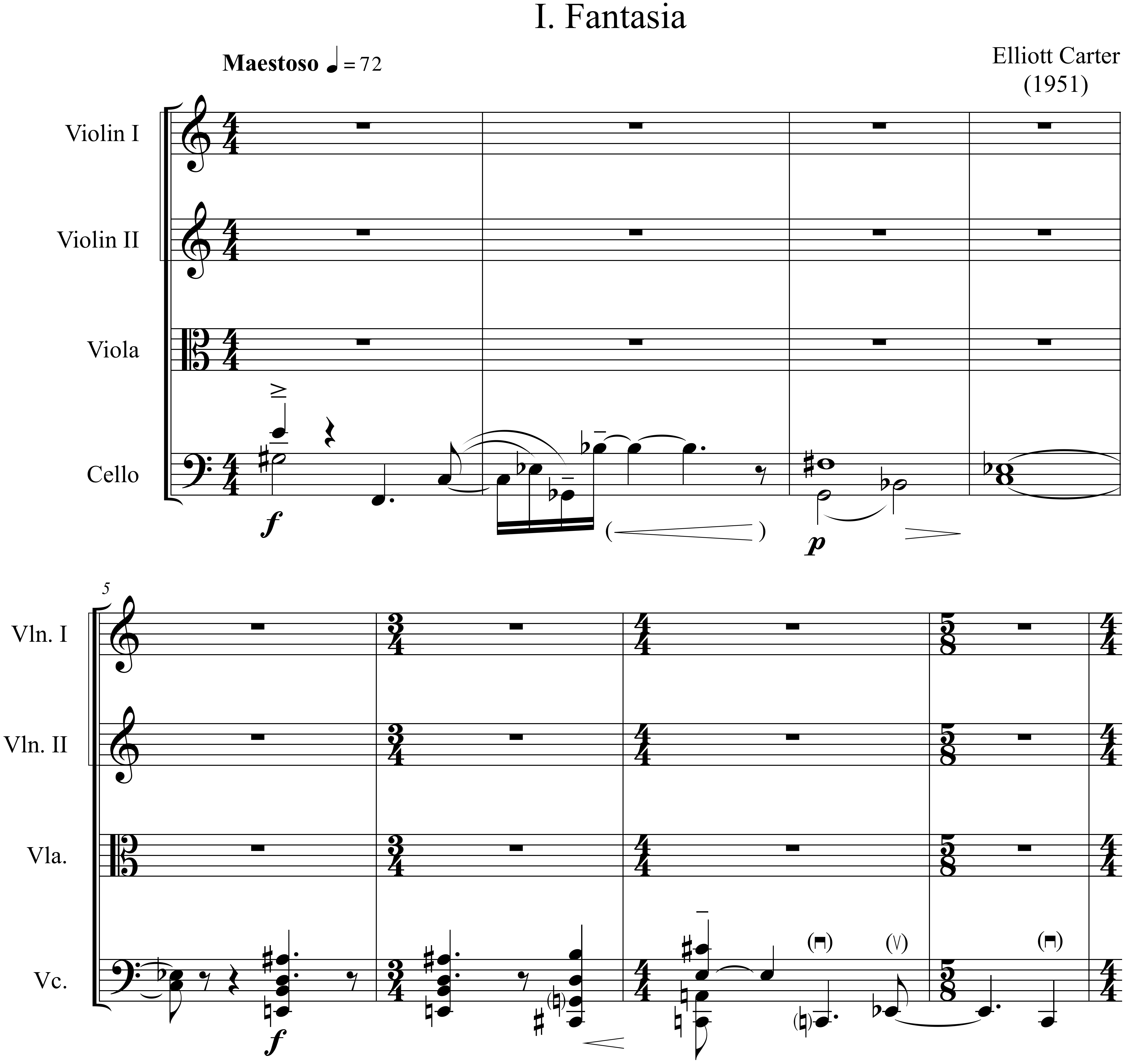Album Leaf
The Sense of Opening: String Quartet No. 1
Nancy Yunhwa Rao
Elliott Carter, String Quartet No. 1, sketch page no. 6 (detail)
Elliott Carter Collection, Library of Congress [View at the Library of Congress website.]
In loose sheets of music paper, 538 pages of manuscript for Elliott Carter's String Quartet No. 1 have survived. They were deposited and then given to the Library of Congress as a gift in 1963. This leaf shows the composer using lines to depict proportional durations, shape, and characteristics, reflecting a kind of mental essence about a musical impulse. Written comments also reveal the character of this musical gesture in interesting ways. In subsequent sketches the gesture gradually transformed from graphically sketched idea into the powerfully articulated musical phrases in the published work.
What we see here is the conceptual image of the opening bars of the quartet’s first movement. In the gesturally vivid sketch Carter delineated the Gestalt, the essence. Its shape, momentum, and feel as a whole function as a focal point for the subsequent composition process which Carter reworked in many revisions before the definitive opening emerged. This preliminary impulse is quite abstract, even with its notated music, and Carter evidently struggled to convey the essence as he deciphered its various components into a score by making many technical decisions. Intuition and openness were key in the process, such that the harmonic language, pitch structure, intervallic relationship, and instruments underwent significant changes in subsequent drafts. In the end, Carter relinquished the even, graceful melodic line shown on this leaf in favor of a dramatically compressed gesture. As Carter polished this opening phrase, he gave it entirely different kinds of texture, instrument timbre, tempo, rhythmic characteristics, and melodic contexts.
This sketchleaf is one of nine leaves preserving Carter’s drafts on the opening bars. It begins with one system of six complete bars and part of a seventh. Words, arrows, and vividly drawn straight and curly lines written above the staves not only complement the notated music but convey the essence of the gesture. The word, “resolution” is followed first by a short arrow and then a bracket with a down stroke at the end that comes a little before the end of the line, marking an abrupt endpoint. Above it is a parallel line with arrowhead showing an increased motion from quarter notes to eighth notes. A significant word appears underneath: “careening.” It connotes the sense of moving swiftly and in an uncontrolled way toward an endpoint. Together the words and drawing depict a conceptual image, which Carter composed out below in the first four bars. The dynamic force of this gestural impulse is also projected by the two successive long upward arrows below the first staff. The first arrow spans mm. 1-2 and the second from the beginning of m. 3 to the downbeat of m. 4. The end of the second arrow curves slightly to stress a sense of arrival. The word “up-beat”, placed before the onset of the long arrows, also reveals the temporal effect of mm. 1-3 and reaffirms the arrival of the hypermetrical downbeat on the first note of m. 4.
The written note in the middle top of the page, “working up + incisions,” is visually presented by two graphs to the right, showing flowing lines with interruptions in the middle. Whereas the first part of the note, “working up,” might sum up the gestural impulse we described in the previous paragraph, the notion of “incisions” is less apparent. Its visual representation may lie in the middle of the arch graph where “in faster tempo” is written at the peak. Here incisions could be construed as divisions of notes, as if in faster tempo. It could also be construed visually as the two vertical lines in the smaller graph, implying an interruption of a horizontal line after its first swirl. Either way, the increase of eighth notes in mm. 4-6 expresses the sentiment of busy motion interrupting the upward uncontrollable sweep. Yet, this conceptual image of “incisions” is strong enough that it lasts into the finished version (mm. 5-6), articulated eloquently by three well-paced loud chords of quadruple stops.
Example 1
Elliott Carter, String Quartet No. 1, mm. 1-8
Copyright © 1955, 1956 (Renewed) by Associated Music Publishers, Inc. (BMI) New York, NY

The words and graphics on this leaf offer fascinating clues about the basic shape and impulse of the opening idea, its identity. However, the notated seven-bar phrase is only distantly related to the finished score, if at all. Indeed, in the next eight drafts, Carter revised heavily: he (1) compressed the first four bars into two, (2) contemplated a greater mix of varied note values, (3) enlarged intervallic space between notes to create a powerful falling gesture, (4) stretched out the registral span from a seventh to nearly two octaves, (5) sharpened the end point of “careening” with an abrupt and large upward leap, (6) changed the tempo from M.M. 96 to M.M. 72, and (7) changed the instrumentation for the melody from first violin, to viola, and finally to cello. In this process, the conceptual image of “careening” emerged with greater clarity.
The process of uncovering the details of this preliminary impulse was not linear or even evolutionary. Carter reworked the basic idea by engaging it in many new pitch, rhythmic contexts, while keeping certain parts intact. Although this leaf does not help us predict the subsequent path of revisions, and little of the seven-bar notated music remain intact in the finished version, Carter hastily added a few bars on separate staves whose contour lasted into the final version. On the fourth and fifth staves, Carter jotted down versions of the opening melody in varied rhythm, separating it into three dyad-like gestural segments. If the pitches have little connection to the finished work, the contour of the six-note gestures shows great resemblance in spirit.
